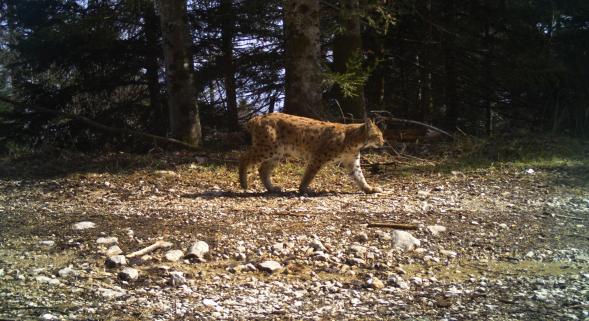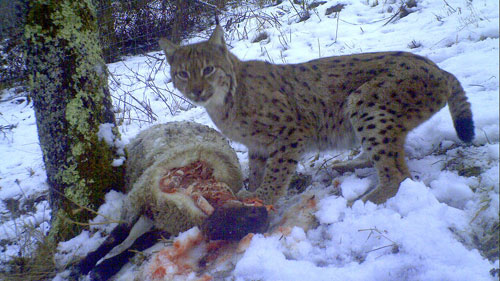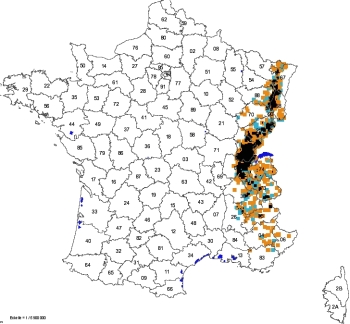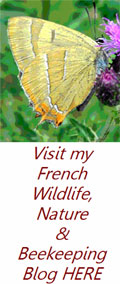The Eurasian Lynx is the largest Lynx species, ranging in length from 80 to 130 cm (31 to 51 in) and standing about 70 cm (28 in) at the shoulder with a tail that measures 11 to 25 cm (4.3 to 9.8 in) in length.
Males usually weigh from 18 to 30 kg (40 to 66 lb) and the smaller females weigh 8 to 21 kg (18 to 46 lb).
They have powerful, relatively long legs, with large webbed and furred paws that act like snowshoes. They also possesses a short "bobbed" tail with an all-black tip, black tufts of hair on their ears, and a long grey-and-white ruff.
Present everywhere in France in the 15th century they became extinct or rare in many regions of western Europe including France during the 19th and 20th century. This dramatic regression which began in the Middle Ages was attributed to the combined action of the fragmentation of forested habitats in connection with agricultural development, to the increasing rarity of wild ungulates and most importantly human persecution. It seems that isolated Lynx probably survived a little longer in the Alps (a lynx killed in 1928 in the Queyras).
Equally in the Pyrenees, although the the last authenticated capture was in 1917 (Pyrénées-Orientales) there have been reports of individuals being trapped since then.
Today the Lynx is present again in France in the Alps, Jura and Vosges.
The French alpine and Jura populations have their origins in the re-introductions made in Switzerland in the 70’s.
Actual French re-introductions were in the Vosges where there were 21 released , 12 males and 9 females, between 1983 and 1993. Unofficial releases may also have occurred in the German Pfalzerwald region in the early 90’s.
The core population in the Vosges is mainly concentrated on the Alsatian side, middle and south. In recent years there has been an increase of the species on the Lorraine side of the middle and southern Vosges. To the north the presence of Lynx in the vast forest complex "North Vosges - German Palatinate" is still sporadic and seems disconnected from the southern core. A study by the ONCFS conducted in 2003 estimated the Vosges population at 30-40 individuals
The largest and most active population demographically is in the Jura with a population of a hundred individuals (ONCFS, 2003). In the south of the mountains all the favorable forest habitats are occupied by lynx, the upper border (east) to the plain of Bresse (west) and Rhône (south).
Further north, the Lynx continues to colonize new territories, mainly in the department of Doubs. Recent evidence now suggests a continued presence of the species across the borders of the departments.
It's not really possible to talk of a core population of Lynx in the Alps. There are no areas of extensive, continuous presence. Only several "islands" scattered throughout the area and focused on the main mountains and forests. For some years now, a core active demographic population appears to be forming in the great forests of the Northern Alps in connection with the Lynx in Jura. Otherwise the presence is still intermittent in the rest of the Alps but has a continuing expansion towards the south with the presence of indices being identified in the north of the Var and west of the Alpes-Maritimes. The population is very difficult to estimate but probably would be of the order of 30-40 individuals (ONCFS, 2003).
Camera traps placed by the ONCFS are providing valuable information.
In the Pyrenees the situation has been very confused with various possible "sightings" and many naturalists convinced of a continuing presence however the ONCFS are not convinced.
Despite a positive trend, the Lynx population in France is very vulnerable because of its small population and its fragmentation. With populations still small and fragmented any deaths from human causes are an issue. Too frequently Lynx are killed from ignorance or for revenge, especially in the Jura and the Vosges. Currently, road, motorway and rail collisions are the most important causes of known unnatural mortality. Juveniles pay a heavier toll than adults.
Increasing traffic is a major cause of mortality for so many species, especially so for species with fragile populations. Photo LeDauphine.com
A more general and widespread problem for all lynx populations of northern Western Europe is the fragmentation of forest by urbanisation and the corresponding infrastructures required. The possibilities of dispersion are greatly reduced and the exchange of individuals between population centers restricted or completely annihilated. Eventually, these isolations can cause a genetic weakening of the population as a whole, especially as the populations came from such a small original genetic pool.
Sheep killed by Lynx in France (ONCFS trail camera set following the kill for the return of the Lynx))






